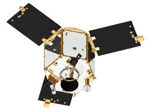

RazakSAT-2 will be run by the National Space Agency (ANGKASA) with a launch date expected in 2015. The new satellite will include updgrades to the hardware and software of the currently orbiting satellite that has captured more than 1,000 images to date.
The investment is said to improve the economic growth of the country, with job creation as well as application in vital industries such as agriculture, forestry, and fisheries. The satellite will also improve mapping and land use planning as well as coastal monitoring.
The existing RazakSAT satellite is the country’s second satellite after the original TiungSAT-1 that was launched in September 2000. RazakSAT carries a pushbroom camera with five linear detectors ( a panchromatic and four multi-spectral). The satellit achieved the intended Near-Equatorial Low Earth Orbit (NEqO) at 685 km altitude and a 9 degree inclination, giving it the ability to revisit the country every 90 minutes. The revisit rate is an important factor because the equatorial location means heavy cloud cover over the country.